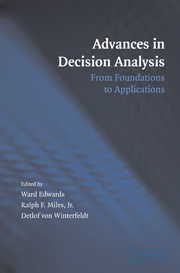Book contents
- Frontmatter
- Contents
- List of Contributors
- Preface
- 1 Introduction
- PART I HISTORY AND FOUNDATIONS OF DECISION ANALYSIS
- 2 The Emergence of Decision Analysis
- 3 The Foundations of Decision Analysis Revisited
- 4 Decision Analysis: A Personal Account of How It Got Started and Evolved
- 5 Reflections on the Contributions of Ward Edwards to Decision Analysis and Behavioral Research
- PART II STRUCTURING DECISION PROBLEMS
- PART III PROBABILITIES AND BAYES NETS
- PART IV UTILITIES
- PART V RISK ANALYSIS
- PART VI DECISION ANALYSIS IN A BEHAVIORAL AND ORGANIZATIONAL CONTEXT
- PART VII APPLICATIONS OF DECISION ANALYSIS
- Index
- References
2 - The Emergence of Decision Analysis
Published online by Cambridge University Press: 05 June 2012
- Frontmatter
- Contents
- List of Contributors
- Preface
- 1 Introduction
- PART I HISTORY AND FOUNDATIONS OF DECISION ANALYSIS
- 2 The Emergence of Decision Analysis
- 3 The Foundations of Decision Analysis Revisited
- 4 Decision Analysis: A Personal Account of How It Got Started and Evolved
- 5 Reflections on the Contributions of Ward Edwards to Decision Analysis and Behavioral Research
- PART II STRUCTURING DECISION PROBLEMS
- PART III PROBABILITIES AND BAYES NETS
- PART IV UTILITIES
- PART V RISK ANALYSIS
- PART VI DECISION ANALYSIS IN A BEHAVIORAL AND ORGANIZATIONAL CONTEXT
- PART VII APPLICATIONS OF DECISION ANALYSIS
- Index
- References
Summary
ABSTRACT. Decision analysis emerged as a discipline separate from decision theory or operations research following World War II. It could not have emerged earlier. It required a stable society with the appropriate philosophy and culture, and a sufficiently rich mathematical language to think logically about decision making. It required the understanding of subjective probability of Ramsey (1926) and de Finetti (1931, 1937), and the appropriate measure of preference under uncertainty of von Neumann and Morgenstern (1947) and later of Savage (1954). It formally came into being with the naming by Howard and his merger of decision theory and systems analysis.
(1966).This chapter draws on several historical reviews on the development of probability and utility cited in this chapter and on reviews of the emergence of decision analysis (Edwards 1954, 1961; Raiffa 1968, 2002; Smith and von Winterfeldt 2004; von Winterfeldt and Edwards 1986). This chapter starts with the first intellectual awakenings of the mind of humans. From there it traverses through the origins of mathematics, Greek philosophy, the Renaissance, and on into the twentieth century. It concludes with the significant publications of Howard (1965, 1966, 1968) and Raiffa (1968). This book is only a way point in the progress of decision analysis. Decision analysis can be expected to experience significance advances throughout the twenty-first century and beyond.
- Type
- Chapter
- Information
- Advances in Decision AnalysisFrom Foundations to Applications, pp. 13 - 31Publisher: Cambridge University PressPrint publication year: 2007
References
- 4
- Cited by



